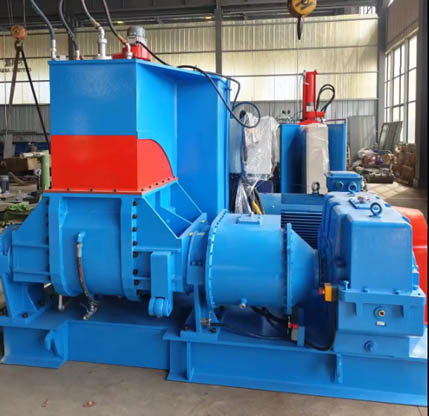Dispersion kneader develop over time and become the most common type of mixing mixer machine in the rubber industry. Dispersion kneader mixers are mainly used for the plasticating ,polymerization and mixing of natural rubber, synthetic rubber, reclaimed rubber and plastic, it is applied with a wide range of material mixtures, from low viscosity adhesives to high viscosity polymers.
During the process, the compound material (maybe rubber, plastics, chemicals and many other polymers ) are squeezed and sheared in intensive mixer under specified temperature and pressure conditions ,so that disperse, plasticize and mix the material uniformly. This would result in a uniform mixture with a good material distribution, it is suitable for manufacturing various sections and shapes of hot rubber and rubber compounds, it is also applied in silicone rubber, sealant, hot melt glue, food base, ink, electrical cables, conveyor belts,hi-tech tyres , rubber parts, footwear, power transmission belts, rubber rollers , medicinal preparations and other various sports equipment.
Functions of dispersion kneaders
• Blending process from low viscosity adhesives to high viscosity rubbers.
• Maximum distribution is facilitated by a rotor with double blades, ample clearance, single lining, and rotor construction.
• Dust collector-A specially designed dust collector collects spilt dust, saves raw materials and prevents pollution.
• High-quality alloy steel rotors with reinforced edges and forged alloy steel helical gears improve wear resistance.
Hydraulic dispersion kneader machines offer numerous advantages that make them a preferred choice in various industries.
These benefits include improved product quality, efficient operations, versatile applications, and ease of use and maintenance.
Advantages of hydraulic dispersion kneader
✔ Improved Product Quality and Consistency
These hydraulic dispersion kneaders ensure consistent quality compounding through automated continuous hydraulic compression and excellent dispersion of ingredients. This results in uniform mixtures and higher product quality, catering to the stringent demands of industries such as automotive, healthcare, and consumer products.
✔ Efficience and Energy-Saving Operation
Hydraulic dispersion kneader machines offer remarkable efficiency with batch preparation times of just 7-12 minutes.The innovative shaft seals with lubrication passage help prevent ingredient leaks, further enhancing the machine’s efficiency.
✔ Easy Operation and Maintenance
The intensive mixer kneader are designed for user-friendly controls and easy to operate. They rarely need maintenance.
✔ It helps in dust collection
Wet or dry foam specially created to keep the environment clean and can be replaced immediately.
✔ Has an effective Cooling system
The intensive mixer has an effective cooling system to control overheating.
✔ Versatility and Wide Range of Applications
Rubber for industrial usage is produced using a complicated process that involves compounding raw rubber with several chemicals and additives. Since rubber is a thermoset material , after natural or synthetic rubber is made , it is delivered to processor plants to be processed into the final product.
To get the compound the desired shape and qualities, it need to processed through some other machine , which be utilized to make a variety of goods through four main process ,including compounding, calendering, extrusion and press moulding.
Compounding
Compounding mixing machines , it is also known as dispersion kneader machinery , are designed to measure out the right quantities of raw rubber, process oils, carbon black, and rubber chemicals to create a rubber compound. They then mix these elements together, creating a rubber compound that is ready for processing.
Extrusion
Extrusion machines force uncured rubber through a die under pressure. This creates a shaped sheet – or ‘profile’, as it is known within the industry. A set of rotating knives (or die face cutters) then convert the resulting extruded material into slugs or pellets for further processing.
Shaping
Shaping of the mixture into the desired form proceed in several ways. Extruders are used to produce long continuous products such as tubing, tire treads, and wire coverings. They are also used to produce various profiles that can later be cut to length. Roller calenders machine are used to make wide sheeting. In transfer and injection molds, the rubber mixer is forced through channels into a mold chamber of the required shape, where it is cured under pressure.
Vulcanisation
Vulcanising rubber can involve a number of different machines and processes depending on the desired result. The type of product will also determine which vulcanisation method is used.







